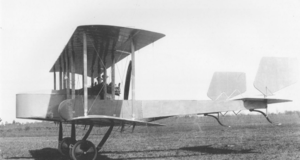| Ca.37 | |
|---|---|
 | |
| Role | Ground attack aircraft |
| National origin | Italy |
| Manufacturer | Caproni |
| First flight | 1916 |
| Number built | 1 |
The Caproni Ca.37 was a ground attack aircraft designed and built in Italy by Caproni around 1916.
| Ca.37 | |
|---|---|
 | |
| Role | Ground attack aircraft |
| National origin | Italy |
| Manufacturer | Caproni |
| First flight | 1916 |
| Number built | 1 |
The Caproni Ca.37 was a ground attack aircraft designed and built in Italy by Caproni around 1916.
During 1916 Caproni embarked on the design of a small light ground attack aircraft which followed the design philosophy of its much larger cousins the Ca.3 and Ca.4. [1]

The Ca.37 followed the twin boom layout with central nacelle, which housed the tandem cockpits and the 190 kW (250 hp) Lancia Tipo 4 6-cylinder in-line piston engine, driving a 2-bladed pusher propeller. The tail-plane spanned across the two tail-booms and mounted two all-flying rudders for yaw control. Twin main-wheel units were strut mounted under each boom which also carried wooden tail-skids. [1]
The front cockpit was to house a gunner with a flexibly mounted machine-gun. Small bombs were also to be carried for trench attacks and anti-personnel attacks. [1]
Limited further development, in the form of streamlined pod and booms, was carried out as the Ca.38, but no production resulted. [1]
Data from Aeroplani Caproni [1]
General characteristics
Performance
Armament

The Caproni Ca.1 was an Italian heavy bomber of the World War I era.

The Caproni Ca.2 was an Italian heavy bomber of the World War I era.

The Caproni Ca.97 was a civil utility aircraft produced in Italy in the late 1920s and early 1930s. As originally designed, it was a high-wing braced trimotor monoplane of conventional configuration with one engine mounted on the nose and the other two carried on strut-mounted nacelles at the fuselage sides. Examples were also produced with only the nose engine or only the two nacelle-mounted engines.
The Grahame-White Ganymede was a prototype British heavy night bomber intended to serve with the Royal Air Force in the First World War. A large, three-engined, twin-boom biplane, the sole prototype Ganymede did not fly until after the war had ended, and although an attempt was made to convert the aircraft to an airliner, it was unsuccessful.

The Vickers Type 161 was an unusual 1930s pusher biplane interceptor, designed to attack aircraft from below with a single upward-angle large calibre gun. The aircraft flew well but the concept was abandoned and only one was built.

The Caproni Ca.71, originally Ca.70L, was a two-seat biplane night fighter produced in Italy in 1927. It was derived from the Caproni Ca.70 of 1925.

The Siemens-Schuckert L.I was a large, three-engined biplane bomber aircraft, built in Germany towards the end of World War I. It was a twin boom design, strongly influenced by the successful Caproni Ca.3. Three were built but not used operationally.
The Oeffag G , sometimes known as the Oeffag Type G or Oeffag-Mickl G, was a three-engined reconnaissance flying boat built in Austria during the First World War and deployed by the Kaiserlich und Königlich Seefliegerkorps.
The Caproni Ca.61 was an Italian heavy day bomber aircraft of 1922. It was the final development of the Caproni three engine, twin boom biplane types developed during World War I, but it was not put into production.
The Caproni Ca.66 was an Italian night bomber designed to reequip the post-World War I Italian Air Force. Only two examples of the four-engined biplane were built.

The Halberstadt G.I was a German prototype heavy bomber built by Halberstädter Flugzeugwerke during World War I.
The Caproni Ca.131 was a prototype for a large aircraft built in Italy in 1934, intended for use as either a bomber or airliner. It was a conventional low-wing cantilever monoplane, powered by a radial engine on each wing and in the nose. The main undercarriage was housed within large streamlined spats. Configured as an airliner, it would have seated 17 passengers.

The Bréguet XI was a prototype French biplane bomber of the First World War.
The Caproni Ca.66 and Caproni Ca.67 were Italian night bomber aircraft designed to re-equip the post-World War I Regia Aeronautica.

The Caproni Ca.72 was an Italian night bomber designed to reequip the post-World War I Italian Air Force.
The Caproni Ca.103 was a biplane twin-engine bomber developed by the Italian company Aeronautica Caproni in the late 1920s.
The Caproni Ca.120 was a three-engine monoplane bomber built by Caproni in the 1930s.
The Caproni Ca.127 was a single-engine reconnaissance monoplane built by Caproni in the mid-1930s.
The Caproni Ca.142 was a three-engined multirole aircraft built by Caproni in the mid-1930s.

The Caproni Ca.53 was an Italian prototype light bomber built in the last months of World War I.